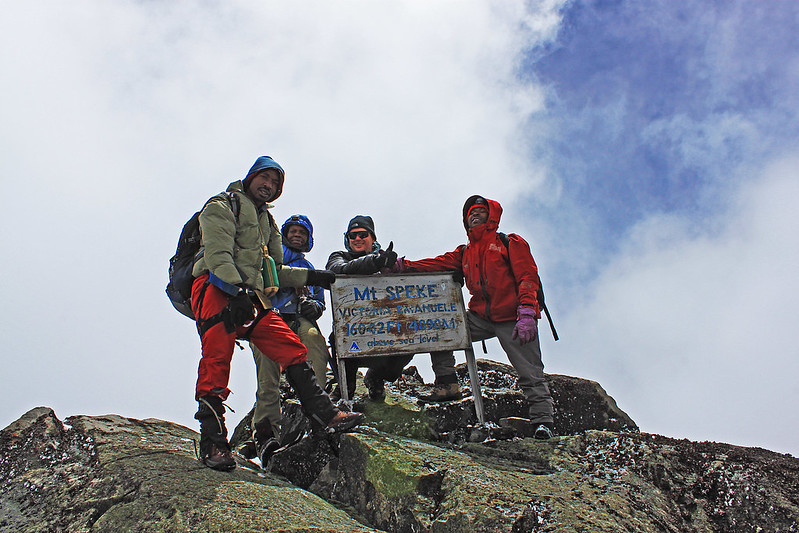Do you want to hike at a low or high altitude across the magnificent Rwenzori mountains? All of this is achievable at Africa’s third-highest peak, also referred to as “the mountains of the moon.” Travelers must be prepared to ascend to a height of 13,123 feet (4000 meters) above sea level for low altitude mountain climbing adventures, which last between two and four days, while high altitude climbs go higher and last between four and twelve days.
The magnificent experience of hiking the huge Rwenzori mountains can be done as a standalone vacation or in conjunction with other excursions. These excursions include seeing animals in the close-by Queen Elizabeth National Park as well as trekking through the Bwindi Impenetrable National Park to see gorillas and the Kibale Forest National Park to see chimpanzees.
Climbers that attempt the Rwenzori Mountain are consistently astounded, despite the fact that it doesn’t garner as much attention and admiration as Tanzania’s Mount Kilimanjaro. This is a result of the distant settings, shifting vegetation zones across mountain slopes and at various altitudes, fluctuating weather patterns, fewer tourists, and truly extraordinary experiences.
About the Rwenzori Mountains National Park.
Due to its biological diversity, the 996 square kilometer Rwenzori Mountains National Park was initially included in the gazette in 1991. It later acquired international designation as a UNESCO World Heritage Site in 1994 and as a Ramsar Site in 2008. More than 70 different mammal species can be found in this park, including blue monkeys, black and white colobus monkeys, forest elephants, huge forest hogs, leopards, chimpanzees, and bushbucks. With over 217 bird species, including 17 species unique to the Rwenzori ranges and 59 species unique to the Afro-tropical highlands biome, it is also a significant place for birdwatching. While exploring the magnificent Rwenzori Mountain, you may come across any of these creatures and birds for a spectacular experience.
There are six stunning mountains that make up the Rwenzori Mountain range. The tallest of these is mountain Stanley (16,043 feet), followed by mountains Emin (4,798 meters/15,741 feet), Baker (4,843 meters/15,889 feet), Savioa (4,627 meters/15,328 feet), and Gessi (4,715 meters/15,470 feet). You should spend at least 9 days in the region to get the most out of your hiking in the Rwenzori mountains.
If you haven’t ascended the breathtaking Rwenzori mountains, even if you have climbed Mount Everest, Mount Kilimanjaro, or the Alps, you don’t know what you are missing. The 996 square kilometer Rwenzori Mountains National Park in Uganda protects the mountain ranges since they are situated along the boundary between Uganda and the Democratic Republic of the Congo. This protected area is distinguished by breathtaking rocky outcrops, various plant species, glacial lakes, snow-capped summits, cliffs, and open spaces, which together offer an extraordinary escape into the magical realm.
How hiking the Great Rwenzori mountains is done.
While Margherita, the highest summit in the great Rwenzori mountains, is described as a “technical climb” requiring a certain level of athleticism, hiking around the mountains still demands moderate fitness levels. In order to satisfy the desires of birders, botanists, nature enthusiasts, animal lovers, and tourists interested in breath-taking views, there are a variety of hiking alternatives available, ranging from two to twelve days. A once-in-a-lifetime chance for motivated climbers to acclimate to elevations where peace, breathtaking views, and a sense of accomplishment can be attained is provided by lengthier climbing pathways for private groups.
The Margherita summit is located at 5,109 meters above sea level and is accessible via two well-known Rwenzori Mountain hiking trails, which are as follows:
The central circuit.
The center circuit, which was started by Luigi di Savoia in 1906, emerges from Nyakalengija and is the oldest. Normally, it takes 7 to 9 days to complete this circuit by hiking.
The Southern circuit.
Another well-traveled trail on the Rwenzori mountains was established in 2009 and begins in Kilembe. It usually takes 6 to 9 days to complete and connects to the central circuit at Kitandara Lakes.
What to pack when planning your hiking the great Rwenzori Mountains experience.
Travelers are encouraged to pack the various necessary hiking gear in order to have the best experience possible when trekking the magnificent Rwenzori mountains. Among them are cozy safari pants, gardening gloves, long sleeve shirts, safari hats, durable hiking boots, lightweight rain jackets, and a camera to document all the breathtaking vistas encountered while hiking. Additionally, you can pack good-quality sleeping bags, thick cotton socks, and essentials like lip balm, a toothbrush, a hair comb, wet wipes, and a small towel. For this trip, you’ll also need a water bottle, a first aid kit with altitude sickness pills, plasters, pain relievers, bandages, and tweezers, a rainproof backpack, energy-boosting snacks, warm sweaters, and binoculars, among other things.
When to hike through the Great Rwenzori Mountains.
The Great Rwenzori Mountains can be hiked throughout the year, but if you do, be prepared for snow and fog if you go in the moist months of March to May and October to November. Since trails typically become muddy and hazardous after heavy rains, the views will be obstructed as a result. Peaks are clearer during the dry months of June through early September and December through February because there are fewer rainy days and less fog. The dry seasons are the ideal and peak times for Rwenzori mountaineering expeditions as a result of this experience.
In addition to the Rwenzori, mountain climbing excursions are offered in Uganda on the Elgon and Virunga mountains, which span Uganda, Rwanda, and the Democratic Republic of the Congo, as well as the Moroto, Kadam, and Morungole peaks in the Karamoja region of northeastern Uganda.


Leave a Reply